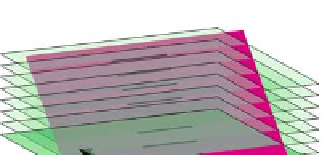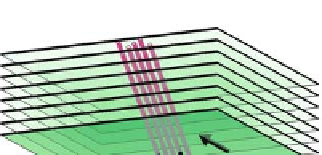Image Processing Reference
In-Depth Information
Fig. 12.2. (
Left
) The uniform motion of a line in the image plane generates the
magenta plane
in the 3D spatio-temporal signal. (
Right
) The uniform motion of a set of points, shown in
black
, generates a set of parallel lines, drawn in
magenta
flow field will be a good approximation of the motion field, although there are nu-
merous circumstances in which the approximation will be poor. In terms of a rotating
sphere, we will discuss the distinction between the two fields and the identification of
the motion from images of the motion further in Sect. 12.12. Below we will summa-
rize the essentials of the translational motion assuming that the motion field equals
to the optical flow and vice versa.
We will study the motion by modeling it as a 2D image patch that has been
brought into motion according to a model, e.g., a translation or an affine motion.
When doing this we also assume that the following constraint is satisfied by the
spatio-temporal image observations:
Definition 12.2 (BCC).
The
brightness constancy constraint
(BCC) is satisfied if the
colors of the spatio-temporal image points representing the same
3
D points, remain
unchanged throughout the spatio-temporal image.
The simplest motion model is the translational model. In the following we discuss
how the 2D content influences the computation of the translational motion. The ob-
servability of translation depends on the directional content of the 2D pattern brought
into such a motion. Leaving out the nonobservable translation of a constant (gray
value or color), there are two fundamental classes that can be discerned:
•
The translation of linearly symmetric 2D images, i.e., the linear symmetry com-
ponent of the 2D structure tensor is nonzero whereas the balanced direction com-
ponent is zero.
•
The translation of 2D images that have more than one directions, i.e., the bal-
anced direction component of the 2D structure tensor is nonzero.
Assuming a continuum of image frames, i.e., a continuous 3D volume, the motion
of a line generates
isosurfaces
4
that are equal to a tilted plane. If there are more
parallel lines in motion there will be more layers of planes that will be parallel to
each other, like a cheeseburger. The more the motion plane tilts, the faster the motion
4
An isosurface is the set of points for which
f
(
x, y, t
)=constant.





